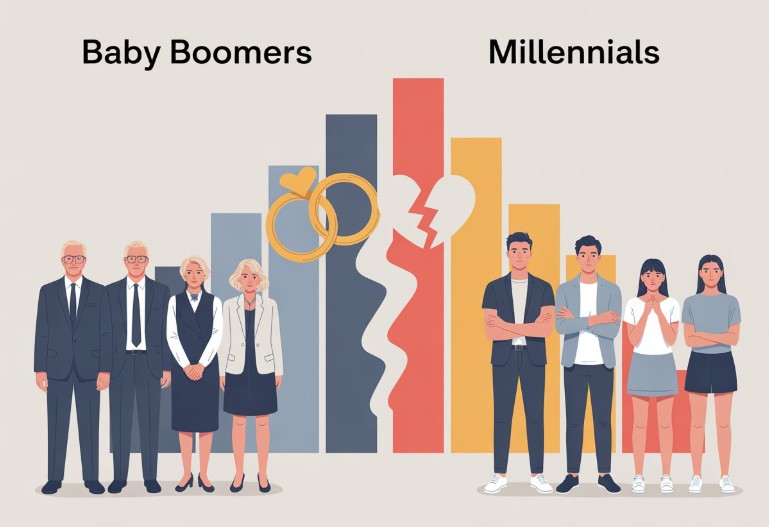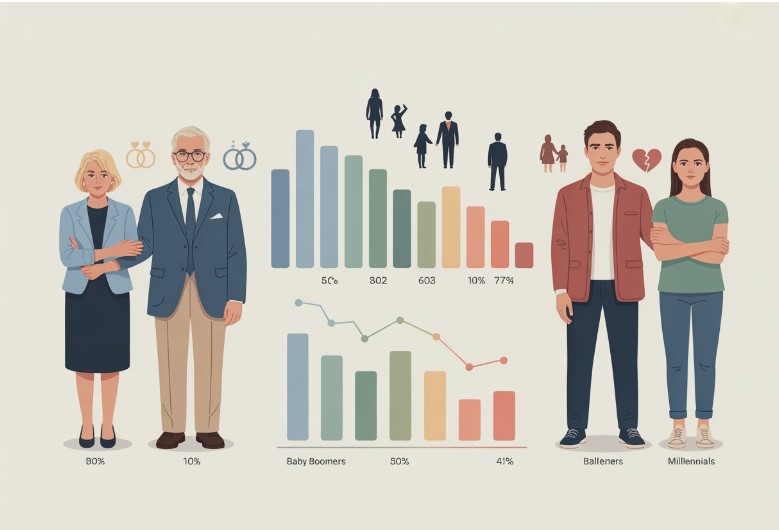

Originally published: August 2025 | Reviewed by Larry Hudspeth

Divorce patterns have shifted a lot between baby boomers and millennials. The way each generation approaches marriage and separation feels surprisingly different if you dig into the numbers.
Most people assume that younger individuals split up more often, but the data doesn’t really support that. Commitment and relationship choices have evolved in ways that might surprise you.
Baby boomers actually hold the title for the highest divorce rates among all generations. Millennials, on the other hand, divorce less—even though modern life throws plenty of curveballs their way.
This shift reveals a great deal about how people perceive marriage today. Younger Americans seem more cautious about walking down the aisle.
The numbers offer some real food for thought about what keeps couples together—or pushes them apart—over the years. There’s more going on beneath the surface than just statistics.
Examining these generational differences in divorce can help us understand broader social trends. Consider the declining birth rates or the way families are structured now compared to decades ago.
Why do these patterns exist? It’s not just about numbers. Economic stress, shifting values, and even technology play a role in how each generation forms relationships.

Comparing divorce rates between Baby Boomers and Millennials highlights how society is constantly evolving. Both groups faced different pressures, and that shaped their views on love and marriage.
Baby Boomers went through a period of unusually high marriage breakdowns. Many of them married young—sometimes way too young—and went through more than one divorce.
Millennials?
Their pattern looks nothing like that. Only 26% of Millennials are currently married, while 48% of Baby Boomers had tied the knot at the same age. That’s a significant gap, which creates very different divorce statistics by generation.
Seeing these differences helps families—and anyone working with them—understand how much has changed. The divorce rate isn’t just a number; it tells us about:
Key Marriage Rate Comparison:
Millennials have the lowest divorce rate so far. But fewer of them are even getting married in the first place.
That helps explain why the U.S. divorce rate is falling. They tend to wait longer to get married and appear to choose partners with greater care.
Divorce trends show generational differences—but your needs are unique. L. Hudspeth Family Law can guide you through divorce representation in North Carolina. Contact us today.
If you’re ready to get started, call us now!

Baby boomers have the highest divorce rates of all the generations. Research pegs their peak divorce rate at nearly 40%.
If you were born between 1946 and 1964, you’re part of the boomer club. This group changed how Americans think about marriage and divorce.
Marriage rates by generation look pretty telling:
Boomers often prioritized their careers over family when they were younger. Both parents worked full-time, which sometimes put a strain on their marriage.
This trend hasn’t stopped. Divorce rates for adults 50 and up keep rising—boomers are leading the charge. Every day, over 10,000 boomers turn 65.
The rising divorce rate among older adults is directly tied to the boomers’ aging. They divorced a lot when they were young and keep divorcing as they get older.
Honestly, boomers broke the mold on marriage. The trends they initiated are still evident in today’s divorce statistics.
Millennials approach marriage differently than their parents or grandparents did. They’re a lot more careful before saying “I do.”
Only 26% of millennials are married. That’s a significant drop compared to previous generations. Gen Xers reached 36% marriage at the same age, and Baby Boomers were at 48%.
Millennials are waiting longer to get married and have kids. They take their time, hoping to find the right person.
Millennials are more open to interracial and interfaith relationships. With a wider dating pool, maybe it’s easier to find a good match.
Millennials lag behind other generations at the same age in three areas:
Here’s the twist: Millennials’ divorce rate is actually lower than that of older generations. When they marry, it seems like they’re more selective.
Several key factors contribute to the fact that Baby Boomers have the highest divorce rates compared to younger generations.
Millennials deal with different economic headaches. Student loans, expensive housing, and career uncertainty make them delay marriage. By the time they do marry, they’re usually more stable—financially and emotionally.
Gender roles have changed a ton from one generation to the next. Boomers married when expectations were stricter. Women had fewer choices and less independence.
Now, millennials grow up with more flexible roles. Both partners tend to work and split chores. Relationships feel more balanced from the start.
Millennials are more cautious about marriage than Boomers ever were. They’re more likely to live together first and wait for the right person.
Boomers tended to marry young, often simply following societal expectations.
Couples today can find relationship advice and counseling with a few clicks. They can tackle problems before things get out of hand.
Key Differences:
Whether navigating gray divorce or planning for a first marriage, L. Hudspeth Family Law helps with property division in North Carolina. Schedule your consultation now.
If you’re ready to get started, call us now!
The evolving divorce rates by generation illustrate how American society continues to shift. These patterns suggest deeper shifts in values and life choices.
Millennials face various financial hurdles, including student debt and high rents. They become more cautious about major life choices, such as marriage.
Dating apps and social media provide people with more opportunities to meet potential partners. Sometimes that leads to better matches, though it also changes how people date compared to the boomer era.
Society is increasingly accepting of various family arrangements. There’s less pressure to stay in a bad marriage. Women have more financial freedom and more choices.
Many Millennials prioritize education and career before settling down. That delay can lead to more mature decisions about picking a life partner.
People are talking about mental health more, and compatibility and emotional well-being matter in relationships. Therapy and counseling are just part of the toolkit now.
All these generational divorce differences reflect how society adapts to new challenges. Every generation faces its own set of hurdles—and finds its own way forward.
Every generation hits different roadblocks when ending a marriage. Knowing what to expect helps people make smarter choices during such a tough time.
Baby Boomers often face tricky financial situations. They might have retirement accounts, real estate, and decades’ worth of shared stuff to sort through.
Starting over financially later in life can feel daunting for many boomers. It’s not just about splitting assets—it’s about figuring out what comes next.
Millennials typically have fewer assets, but they often carry more debt. Student loans and credit card balances bring their own headaches to family law cases.
Divorce can be costly compared to what millennials earn, which only adds to the stress. It’s tough to balance those costs with everything else going on.
Regardless of age, everyone should pull together their important documents before filing:
Technology issues come up differently for everyone. Millennials may need to manage digital assets, such as cryptocurrency or online businesses.
Some Baby Boomers might struggle to access electronic financial records, especially if they haven’t kept up with the latest technology.
Children’s needs shift, too. Boomers may find themselves thinking about adult children or even grandkids.
Meanwhile, millennials often focus on young children and custody arrangements, which can become complicated quickly.
Legal representation makes a difference for both groups. Generational divorce differences mean lawyers should really get what matters most to each generation.
Timeline expectations aren’t the same for everyone. Millennials may push for a swift resolution due to work or life demands.
Boomers sometimes want to take things slower, especially if they’re worried about protecting their retirement funds.
It’s worth taking time to learn your state’s family law requirements before filing. A little preparation can go a long way in reducing stress and surprises when divorce proceedings begin.
The data reveals clear patterns between generations and their approaches to marriage and divorce.
Baby boomers have higher divorce rates than millennials. Millennials actually have the lowest rates among recent generations.
Key Factors Driving These Differences:
Millennial divorce rates have actually dropped, while baby boomer rates doubled from the 1990s to recent years.
This trend suggests that younger adults approach marriage with greater caution.
The marriage rates don’t look the same, either. Only 26% of millennials are married, compared to 48% of baby boomers at the same age.
Each generation faces its own challenges when relationships end. Baby boomers often face complex financial situations after decades of being together.
Millennials? They might worry more about careers and student debt.
Generation X falls between these two groups, with divorce rates slightly lower than those of Baby Boomers but higher than those of Millennials.
Boomers and Millennials face different divorce realities, but both deserve trusted guidance. L. Hudspeth Family Law supports clients in child custody cases. Contact us to get started.
If you’re ready to get started, call us now!
What is the divorce rate for Baby Boomers?
The divorce rate for Americans over 50 has doubled since 1990, with one in four divorces now involving couples in this age group.
Why is the divorce rate higher among Boomers?
Boomers often married young, remarried multiple times, and live longer lives—factors that increase the likelihood of divorce later in life.
How do Millennials compare in divorce rates?
Millennials have the lowest divorce rates in modern history, mainly due to marrying later, being more financially stable, and prioritizing compatibility.
Did Millennials really lower the U.S. divorce rate?
Yes. Between 2008 and 2016, the U.S. divorce rate dropped by nearly 18%, and researchers attribute much of that decline to Millennials’ cautious approach to marriage.
What is “gray divorce” among Boomers?
Gray divorce refers to divorce after the age of 50, a trend prevalent among Baby Boomers, which poses unique challenges, such as dividing retirement funds.
What lessons can Millennials learn from Boomer divorces?
Millennials can learn the importance of financial planning, communication, and flexibility in relationships, avoiding some of the pitfalls that fueled high Boomer divorce rates.
Why do generational divorce trends matter for family law?
Understanding generational divorce trends enables attorneys to offer tailored guidance, whether it’s retirement planning for Baby Boomers or prenuptial strategies for Millennials.